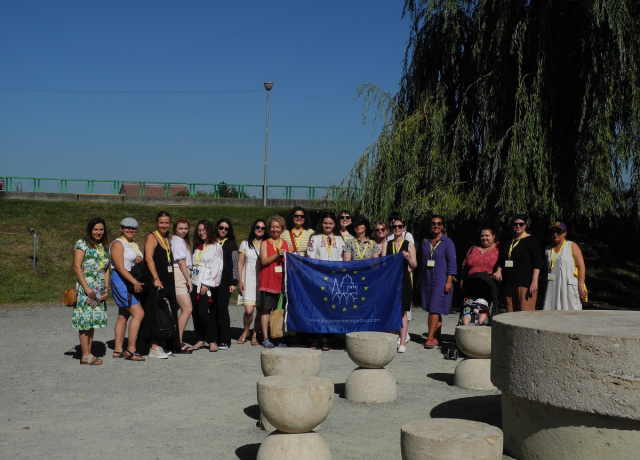European Heritage Days Article:
Lived-in Heritage: an architectural study project between Romania, Scotland and Ukraine
European Heritage Days Article:
Lived-in Heritage: an architectural study project between Romania, Scotland and Ukraine
An overview of the project aims
The Lived-in Heritage project was designed to help promote cooperation between academia and practice within the cultural heritage sector across Europe, particularly for historic urban environments. Falling within the framework of European Cross-Frontier Cooperation Projects for the European Heritage Days joint action of the Council of Europe and the European Union, the project was internationally represented by participants from the Polytechnic University Timișoara in Romania, Yuriy Fedkovych Chernivtsi National University in Ukraine, and The University of Edinburgh in Scotland.
The project was also inspired by the European Heritage Days 2022 shared theme of Sustainable Heritage, with an emphasis on engaging communities in decision-making, demonstrating how architecture is important in preserving local identities, and how traditional restoration techniques can be socially and environmentally sustainable. Postgraduate students from the universities as well as colleagues from the wider field took part in three activities in 2022: two online meetings and a four-day on-site workshop in Romania.
International sites
The project primarily focussed on three main sites, one from each participating country.
The Romanian site selected was The Monumental Ensemble of Târgu Jiu which was built in the late 1930s to commemorate the soldiers of the First World War. The ensemble consists of a series of public art installations including the Endless Column, Table of Silence and Gate of the Kiss and is currently on the Tentative List for UNESCO World Heritage status.
In Scotland, the Old and New Towns area of Edinburgh was the focus. This site is notable for its unique architectural character and development, which combines the medieval fortress in the Old Town with the 18th century neoclassical New Town and was inscribed as a World Heritage Site in 1995.
The Ukrainian site was the Residence of Bukovinian and Dalmatian Metropolitans. The 19th century site includes a school, church and gardens showcasing a variety of revival architectural styles from the Byzantine period onwards and has been listed as a World Heritage Site since 2011.

Knowledge exchange meeting
The first activity took place in April 2022 and was a knowledge exchange meeting focussing on sharing research from the three architecture schools. A series of presentations covered a varied programme of topics related to sustainable heritage. For the Edinburgh site, presentations included the outcomes of a week-long workshop involving interviews with the local community and on-site visits to explore social and geographic approaches to the regeneration of historic structures in the Granton area such as the railway station and gas works. Another talk studied the historic development of the High Street in Old Town from the early 19th century onwards and explored issues of authenticity, architectural identity and sustainable tourism. For the Romanian site, and ahead of the in-person visit, there was a presentation focussed on another site in the vicinity – Tudor Vladimirescu Park – which discussed possible landscape development such as improvements to the layout of plants surrounding the fountain and playground areas.
On-site workshop in Târgu Jiu
For the second activity, the students met in-person in July 2022 for a four-day workshop on-site at the Monumental Ensemble of Târgu Jiu in Romania. The workshop involved mixed groups from the three universities working together on set topics to study. Visits to the site, as well as examination of surveys, photographs and historic data helped the groups take into account aspects of the site including vision and axis lines between the monuments, the history of the city’s development such as traffic and nearby skylines, and the differing landscape and environments throughout the length of the ensemble. The workshop concluded with each group presenting their initial findings with a mixture of photographs and diagrams based on their research with considerations for the preservation of the area and potential development.
Final corollary meeting
The final activity in the programme was an online follow-up meeting, which also included presentations by Ukrainian participants who had been unable to attend the first meeting. An overview of the process of gaining UNESCO listing for the Residence of Bukovinian and Dalmatian Metropolitans was given, from tentative list through to nomination and evaluation and finally voting by the World Heritage Committee. Other presentations of heritage sites in Ukraine included the evolution of Saint-Sophia Cathedral in Kyiv and the construction of the new Household Services Centre in Chernivtsi. The session was also designed to discuss more ideas and methodologies for understanding cultural landscapes, particularly from the perspective of community wellbeing. These presentations gave further thoughts based on the outcomes from the on-site workshops, with issues highlighted such as protecting the site’s authenticity and experiential suggestions for development.
A full list of the Lived-in Heritage project participants and partners can be found on the dedicated webpages hosted by the University of Edinburgh at blogs.ed.ac.uk/lived-in_heritage. The meetings and presentations can also be watched, and a multilingual online publication to showcase the findings of the workshops is also planned.
